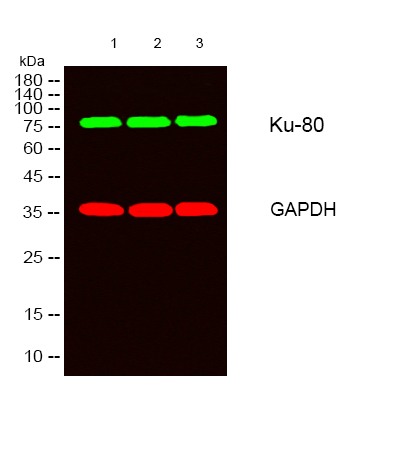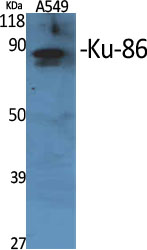TLR3 (Phospho Tyr759) rabbit pAb
- Catalog No.:YP1739
- Applications:WB
- Reactivity:Human;Mouse;Rat
- Target:
- TLR3
- Fields:
- >>Necroptosis;>>Toll-like receptor signaling pathway;>>Hepatitis C;>>Hepatitis B;>>Influenza A;>>Human papillomavirus infection;>>Kaposi sarcoma-associated herpesvirus infection;>>Herpes simplex virus 1 infection;>>Coronavirus disease - COVID-19
- Gene Name:
- TLR3
- Protein Name:
- TLR3 (Phospho-Tyr759)
- Human Gene Id:
- 7098
- Human Swiss Prot No:
- O15455
- Mouse Gene Id:
- 142980
- Mouse Swiss Prot No:
- Q99MB1
- Immunogen:
- Synthesized peptide derived from human TLR3 (Phospho-Tyr759)
- Specificity:
- This antibody detects endogenous levels of TLR3 (Phospho-Tyr759) at Human, Mouse,Rat
- Formulation:
- Liquid in PBS containing 50% glycerol, 0.5% BSA and 0.02% sodium azide.
- Source:
- Polyclonal, Rabbit,IgG
- Dilution:
- WB 1:500-2000
- Purification:
- The antibody was affinity-purified from rabbit serum by affinity-chromatography using specific immunogen.
- Concentration:
- 1 mg/ml
- Storage Stability:
- -15°C to -25°C/1 year(Do not lower than -25°C)
- Other Name:
- Toll-like receptor 3 (CD antigen CD283)
- Molecular Weight(Da):
- 99kD
- Observed Band(KD):
- 120-140,75kD
- Background:
- The protein encoded by this gene is a member of the Toll-like receptor (TLR) family which plays a fundamental role in pathogen recognition and activation of innate immunity. TLRs are highly conserved from Drosophila to humans and share structural and functional similarities. They recognize pathogen-associated molecular patterns (PAMPs) that are expressed on infectious agents, and mediate the production of cytokines necessary for the development of effective immunity. The various TLRs exhibit different patterns of expression. This receptor is most abundantly expressed in placenta and pancreas, and is restricted to the dendritic subpopulation of the leukocytes. It recognizes dsRNA associated with viral infection, and induces the activation of NF-kappaB and the production of type I interferons. It may thus play a role in host defense against viruses. Use of alternative polyadenylation sites to generate
- Function:
- disease:Defects in TLR3 are the cause of TLR3-deficient herpes simplex encephalitis (HSE) [MIM:603029]. HSE is a rare complication of human herpesvirus 1 (HHV-1) infection, occurring in only a small minority of HHV-1 infected individuals. HSE is characterized by hemorrhagic necrosis of parts of the temporal and frontal lobes. Onset is over several days and involves fever, headache, seizures, stupor, and often coma, frequently with a fatal outcome.,disease:Genetic variation in TLR3 is associated with susceptibility to progression to geographic atrophy in age-related macular degeneration [MIM:612479]. Age-related macular degeneration (ARMD) is the most common cause of irreversible vision loss in the developed world. In most patients, the disease is manifest as ophthalmoscopically visible yellowish accumulations of protein and lipid (known as drusen) that lie beneath the retinal pigment epi
- Subcellular Location:
- Endoplasmic reticulum membrane; Single-pass type I membrane protein. Endosome membrane. Early endosome .
- Expression:
- Expressed at high level in placenta and pancreas. Also detected in CD11c+ immature dendritic cells. Only expressed in dendritic cells and not in other leukocytes, including monocyte precursors. TLR3 is the TLR that is expressed most strongly in the brain, especially in astrocytes, glia, and neurons.
- June 19-2018
- WESTERN IMMUNOBLOTTING PROTOCOL
- June 19-2018
- IMMUNOHISTOCHEMISTRY-PARAFFIN PROTOCOL
- June 19-2018
- IMMUNOFLUORESCENCE PROTOCOL
- September 08-2020
- FLOW-CYTOMEYRT-PROTOCOL
- May 20-2022
- Cell-Based ELISA│解您多样本WB检测之困扰
- July 13-2018
- CELL-BASED-ELISA-PROTOCOL-FOR-ACETYL-PROTEIN
- July 13-2018
- CELL-BASED-ELISA-PROTOCOL-FOR-PHOSPHO-PROTEIN
- July 13-2018
- Antibody-FAQs

